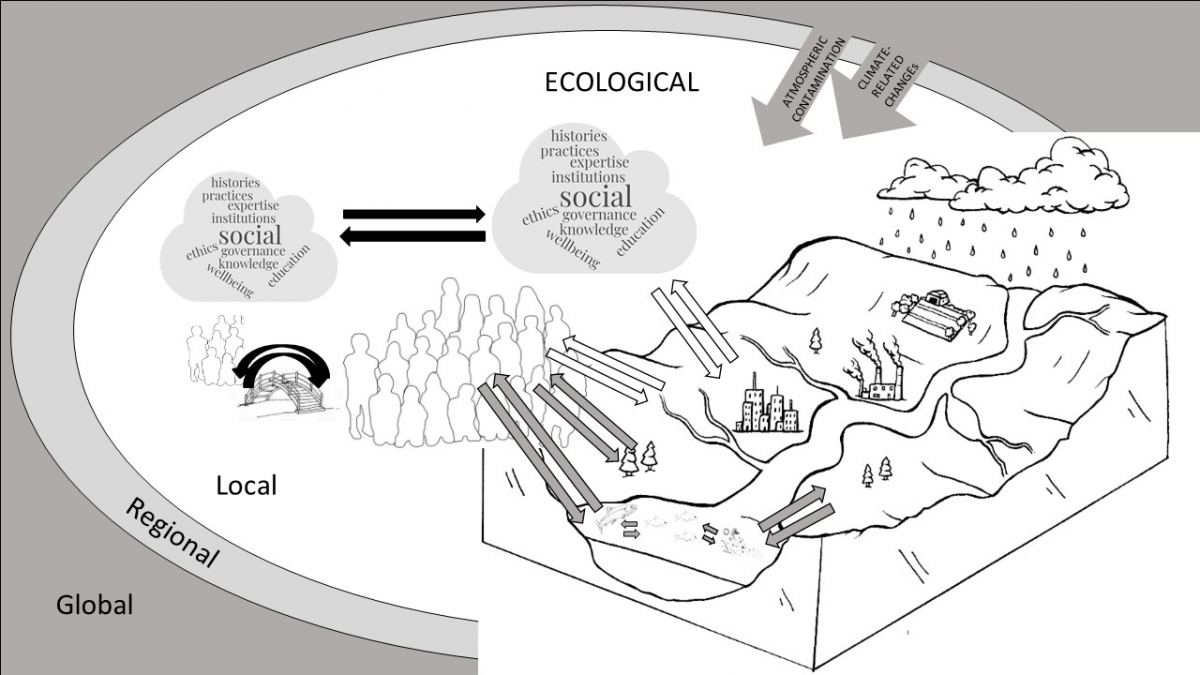What is the tribal landscape system?
The tribal landscape system (TLS) is a broad yet specific term we use to describe the soil, rock, and minerals that make up the lands we live within, the waters that criss-cross and richly inundate parts of the land, the winds and air that fill our lungs and blow through the trees, and the many beings inhabiting the lands, waters, and airways throughout the Keweenaw and the surrounding Ojibwa homelands. In particular, the tribal landscape system is the many multi-directional and constellation of relationships between the land, water, wind, and living systems at any given time and between time(s). The system also consists of a history that informs the present day and will continue to inform the future - the dynamic geologic processes and events reflecting Earth’s deep time, as well as diverse human ideas and values such as political borders, trade and economy, treaty law, and conceptions of property, ownership, natural resources, and more.
Here, the tribal landscape system is the social and ecological system embedded within regional and global environments. The social system includes political and economic structures, the Keweenaw Bay Indian Community and its institutions, governance structures, histories, and knowledges, as well as kinship structures, Ojibwa practices, and culturally-important foods and foodways. The TLS ecological system components include the area landscape of climate, watersheds, fish, and life webs. The KBIC are also connected to the same social and ecological relationships that anyone living in the Keweenaw (or elsewhere) are a part of and yet they are, at the same time, distinct.
In order to better understand and address the impacts and interactions that shape and are shaped by toxic contamination and climate-related changes in the region, it is imperative that we draw from diverse expertise, particularly knowledge systems that originate in the Ojibwa Keweenaw landscape, and are actively practiced as present day experiences by the KBIC. Such understandings can inform knowledge and practice of social-ecological systems research more broadly, contribute to equitable knowledge exchange among diverse groups, and lead to just responses that are relevant and appropriate to those who are burdened by contamination and climate-related change consequences.

Figure 1. The tribal landscape system (TLS) bridges the boundaries of ecological and social sciences by including Indigenous science expertise and knowledge, demonstrating the "two-eyed" seeing approach to research and new discoveries (black arrows, with the non-Indigenous team members and their thoughts to the rear). The goal is to elucidate TLS linkages that are relevant to both Western and Indigenous ways of knowing. Illustrated here, our working model of the tribal landscape system seeks to capture multidirectional dynamics and interactions of a social-ecological system that is perturbed by external forces of atmospheric contaminant deposition and climate-related changes. To understand how these influence and interact within the TLS, the project will characterize the ecological components of the TLS. The team will collect data to understand how differences in watershed characteristics and food webs result in lakes exhibiting different trophic magnification and contaminant mixtures (gray arrows). To characterize how external perturbations impact the human biophysical components, the team will collect data on fish harvesting and consumption (gray arrows), and other landscape practices (lower white arrows). Analyses of these data will be used to clarify how the human social components interact reciprocally with the biophysical system (upper white arrows), through resource management (e.g., location of harvest, the magnitude of harvest, and stocking) and other governance and outreach mechanisms. In turn, the team will evaluate how these actions affect both the extent of contaminant biomagnification and potential exposure (gray arrows), and the tribal knowledge of and kinship with the environment (upper white arrows). For example, the characterization of fish accounts for their role as part of the food web, in supporting tribal fisheries, and as a cultural keystone species. Changes in one component - e.g., contamination or degraded ecosystems - influences and affects the system as a whole.